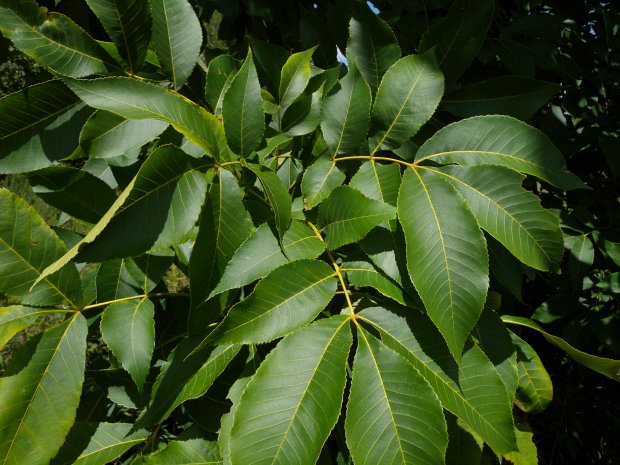
Sweet Pignut Hickory is monoecious, forming separate male (staminate) and female (pistillate) flowers on the same tree. The male flowers are produced in drooping catkins about 2-4" long; they are produced near the tips of branches in groups of 3. Individual male flowers have 4-10 stamens each; these stamens are partially obscured by small 3-lobed bracts that are glabrous, pubescent, or ciliate. Female flowers are produced in short spikes up to ¼" (6 mm.) in length at the tips of branches; there are typically 2-3 female flowers per spike. Female flowers are about 3 mm. in length, ovoid in shape, greenish, and either hairless or pubescent; each female flower has a calyx with 4 upper teeth and a pistil with broad stigmata. The blooming period occurs from mid- to late spring for about 1-2 weeks. The flowers are cross-pollinated by the wind. Afterwards, fertile female flowers develop into nuts with husks that become mature during late summer or fall, when they fall to the ground. The nuts with husks are ¾–1¼" long and a little less across; they are ovoid, obovoid, or broadly ellipsoid in shape. Each husk consists of 4 segments that are relatively thin; the husk surface is relatively smooth, glabrous, and slightly warty. In addition, each husk is slightly winged where its segments join together. At maturity, the husks split open nearly to their bases to release their nuts. The nuts are broadly ellipsoid, slightly compressed (flattened), slightly angular, and light brown; their shells are thick. The meat of the nuts is white and mildly sweet. The root system forms a woody taproot and more shallow lateral roots.
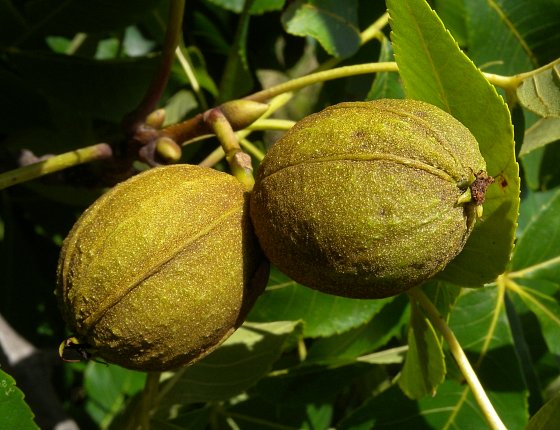
Cultivation: The preference is full or partial sun, mesic conditions, and fertile deep soil containing loam and organic material. However, other kinds of soil are tolerated. This tree can live up to 250 years.
Range & Habitat: The native Sweet Pignut Hickory is occasional in central and southern Illinois, while in the northern section of the state it is absent (see Distribution Map). Illinois lies along the northern range limit of this tree. Habitats include upland woodlands, wooded slopes, bottomland woodlands in well-drained areas, woodland edges, overgrown thickets, and limestone glades. This tree is found in proximity to other deciduous trees, especially other Carya spp. (Hickories) and Quercus spp. (Oaks). Sweet Pignut Hickory occurs primarily as scattered trees, rather than in colonies, and so it is rarely dominant. Occasionally this hickory is used as a landscape plant in parks, but it is rarely used around homes and businesses.
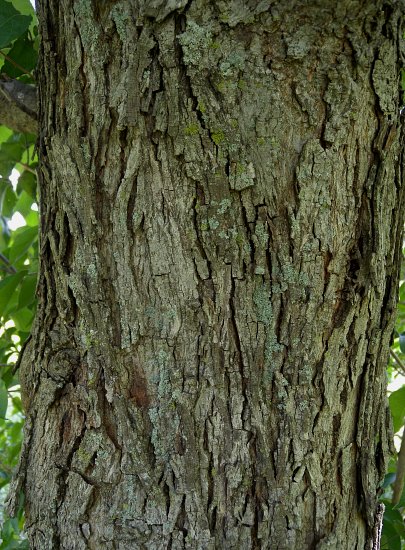
Faunal Associations: Sweet Pignut Hickory and other hickory trees (Carya spp.) attract their fair share of insects that feed on their leaves, wood, plant juices, and nuts. Examples include the wood-boring larvae of long-horned beetles (Anelaphus spp., Goes spp., Neoclytus spp., Saperda spp., etc.), leaf beetles, weevils (Conotrachelus spp.), larvae of gall flies (Caryomyia spp.), plant bugs (Phytocoris spp.), aphids (Monellia spp., Monelliopsis spp., Myzocallis spp., etc.), leafhoppers (Eratoneura spp.), treehoppers (Membracidae), larvae of sawflies (Macrophya spp.), larvae of Geometer moths, larvae of blotch leafminer moths (Cameraria spp., Phyllonorycter spp.), larvae of slug moths (Apoda spp., etc.), larvae of owlet moths (Catocala spp., & others), larvae of prominent moths (Datana spp., Schizura spp.), larvae of Tortrix moths (Olethreutes spp., etc.), thrips (Thrips spp.), and the Northern Walkingstick (Diapheromera femorata). The larvae of two butterflies, Banded Hairstreak (Satyrium calanus falacer) and Hickory Hairstreak (Satyrium caryaevorum), feed on the foliage and catkins of hickories. See the Insect Table for a more complete list of these species.
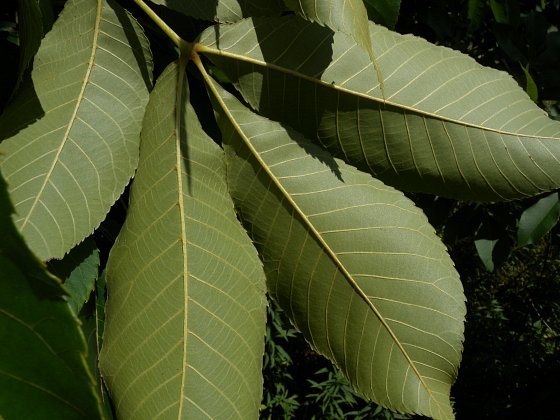
Various birds and mammals eat the nuts of hickories. Among birds, these species include the Blue Jay, American Crow, Wild Turkey, Ring-necked Pheasant, Bobwhite Quail, and Red-bellied Woodpecker (Martin et al., 1951/1961). Insectivorous birds are attracted to these trees because of the large number of insects that they attract. The primary consumers of hickory nuts among mammals are tree squirrels (especially the Gray Squirrel, Fox Squirrel, and Southern Flying Squirrel), although the Black Bear, Gray Fox, Raccoon, Eastern Chipmunk, White-footed Mouse, and Woodland Deer Mouse also eat the nuts. The White-tailed Deer occasionally browses on the twigs and leaves of these trees, especially when they are saplings. Because of the protective cover provided by the large leaves and shaggy bark of some species, bats sometimes select hickory trees for summer roosting sites and maternity colonies, while the cavities within these trees are selected as hibernation sites. Examples of bats that make use of hickory trees for these purposes include the Eastern Red Bat, Evening Bat, Indiana Bat, Northern Long-eared Bat, and Rafinesque's Big-eared Bat (Mager & Nelson, 2001; Carter, 2003; MuÌnzer, 2008; Perry & Thill, 2008; Krynak, 2010; C. Martin et al., 2011; Zimmerman, 2015).
Photographic Location: An overgrown thicket at Meadowbrook Park in Urbana, Illinois.
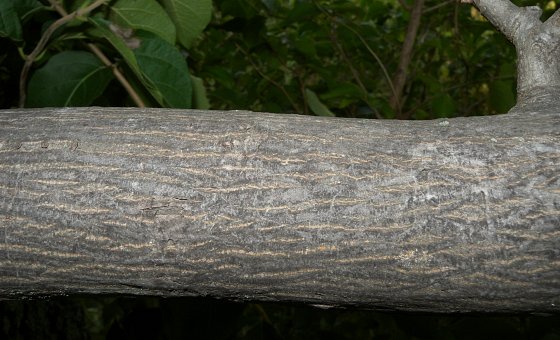
Comments: This hickory has received less attention than other species in its genus because it is sometimes considered a variety of the Pignut Hickory, or Carya glabra odorata. Some authorities even refuse to recognize it as a variety. However, the majority of botanists now consider Sweet Pignut Hickory to be a distinct species, Carya ovalis. This tree should not be confused with the Shagbark Hickory (Carya ovata), which has a similar scientific name. Sweet Pignut Hickory is readily distinguished from Pignut Hickory by having more leaflets per compound leaf (typically 7, rather than 5), shaggier bark (for mature trees), and husks that divide nearly to the base of each nut when they become mature. In addition, the petioles and rachises of the compound leaves are often red, rather than greenish white. However, this coloration can vary with the local ecotype of this tree. While the bark of Sweet Pignut Hickory becomes somewhat shaggy with age, it is still less shaggy than the bark of either Carya ovata (Shagbark Hickory) and Carya laciniosa (Shellbark Hickory). It also has smaller husked nuts than these latter two hickories. In addition to Sweet Pignut Hickory, other common names of Carya ovalis include Red Hickory, False Shagbark Hickory, and Small-fruited Hickory. The wood of this tree is reddish brown or brown, heavy, hard, and strong. It is used for many of the same purposes as the wood of other hickories, including the construction of furniture and sporting equipment.